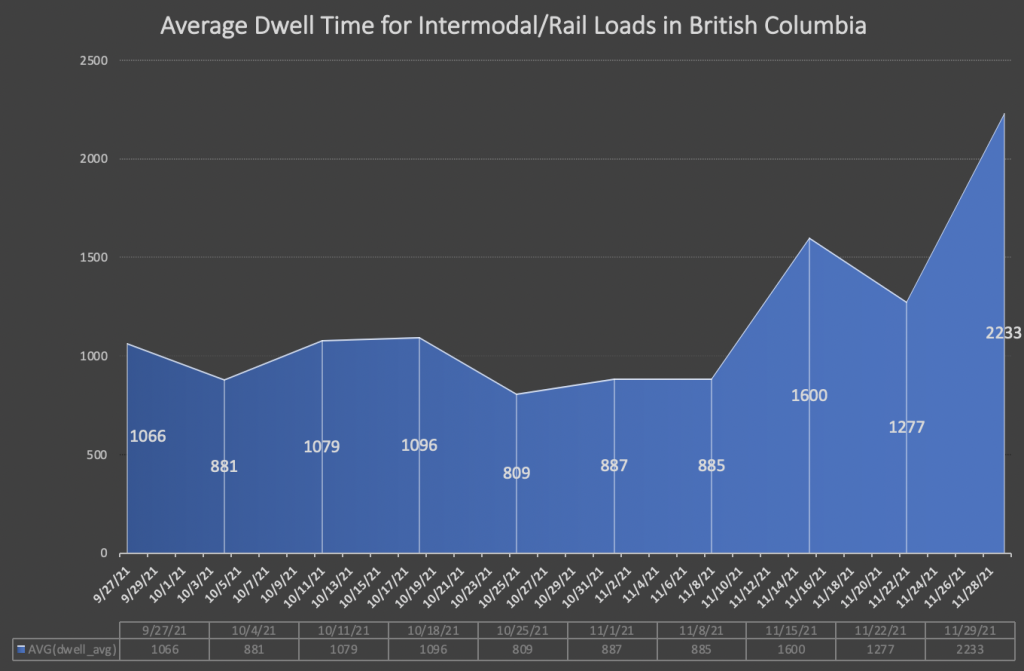After torrential rains called the ‘storm of the century’ hammered British Columbia’s southern interior in mid-November, submerging many communities and critical rail and road links with Canada’s largest port, the supply chain crisis appears to be getting from bad to worse, with the third rainstorm that began Wednesday. While the rainfall was slowing down today (Thursday 12/2/2021), meteorologists indicate it could take several weeks for floodwaters to recede.
Port stakeholders fear that it could take even months for cargo flows to return to normal at a Pacific gateway that moves some C$550 million worth of cargo daily, ranging from bulk commodities to containerized manufactured and consumer goods and automobiles. China-led Asia is, by far, the dominant trading partner of the port which handled 145.5 million tons in 2020.


Already, earlier this year, normal rail service on Vancouver Island was interrupted by another natural disaster: a series of wildfires in July that damaged the CP and CN rail networks linking Vancouver to eastern markets.
When operations began today, there was a backlog of 55 ships at anchor versus 40 on November 19. “Demand for anchorages currently exceeds capacity,” the Vancouver Fraser Port Authority reported.
Vessels awaiting berth space include some 10 containerships and several dozen bulk vessels waiting to load coal and grain.
According to the port authority’s performance data, the rail cargo flow has also seriously deteriorated to “black” from “red” conditions as container dwelling times are surpassing seven days prior to being loaded onto freight trains. One month ago, the dwell times were at a respectable average of 2.6 days at the port’s four container terminals.
In this regard, the VFPA stated: “We are working closely with our container terminal operators, railways and all levels of government to understand the impacts of these delays on terminal operations and to develop a recovery plan.”
To help relieve the mounting congestion at port terminals, the federal government has allocated C$4 million to establish an underdeveloped 40-acre site to store empty containers.
FourKites, a Chicago-based company that operates a “supply chain visibility platform,” recently reported: “We [FourKites] saw a 15% spike in delays of containers coming into the Port of Vancouver in the month of November, compared to the previous two months. The downstream impact of these delays increases costs of imported goods consumers are purchasing during the holiday season; delays finished goods that may rely on raw materials from these shipments; and adds even further pressure to shippers/logistics service providers to service ever-increasing customer expectations for on-time deliveries for the holidays.”

Rail services not fully restored
On the critical railway service front, Canada’s two big railways, CN and CP, have yet to fully restore services.
CN, in fact, on late Monday “protectively” closed its service on the key Kamloops-Vancouver corridor because rain was causing increased debris, washout and landslides. This was after moving seven trains during last weekend.
The Montreal-based railway has been able to divert some traffic to the Port of Prince Rupert. The northern BC port has not been impacted by the severe weather.
CP operations between Kamloops and Vancouver resumed in part mid last week. However, the railway requires access to CN tracks on this corridor in order to maximize capacity.
In its latest report on rail operations, the Port of Vancouver said CP and CN eastbound and westbound trains are continuing to transit on CP’s mainline between Vancouver and Kamloops, with low-speed restrictions remaining in place. “Engineering teams continue to undertake repairs on CN’s mainline between Kamloops and Boston Bar at a site impacted by heavy precipitation. A timeline for restored rail operations through the site is currently unavailable.”
Exports as well as imports are being hampered by the significantly lower ship traffic no longer moving seamlessly through the Port of Vancouver.
Reflecting wide Canadian business concern in this regard was Dennis Darby, President of Canadian Manufacturers and Exporters. “The recovery of the manufacturing sector in general has slowed down and the crisis in BC is just going to make it worse.”
In addition, the floods have temporarily shut down much of the transportation of Canada’s substantial wheat and canola exports.
For the Port of Vancouver, which handled some 145.5 million tonnes of cargo in 2020, including record container throughput of 3.5 million TEUs, the weather-caused logistical nightmare has broken the momentum of steady post-pandemic recovery.
Statistics for the first six months of 2021 showed total cumulative traffic up 6.5% at 76.4 million tonnes. Grain, specialty crops and feed were up 14%. And container volume was up 24% at nearly two million TEUs (another record).

